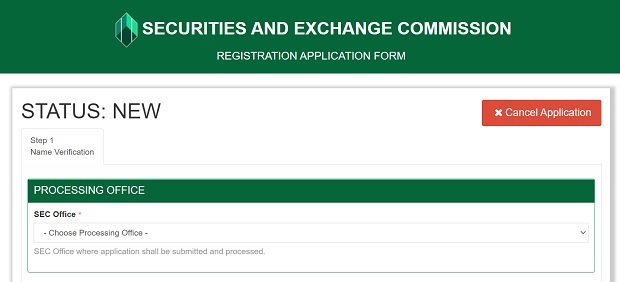The Securities and Exchange Commission (SEC) said 26,875 businesses have used the agency’s Electronic Simplified Processing of Application for Registration of Company (eSPARC) since its launch last April.

In a report to Department of Finance secretary Carlos Dominguez III, SEC chairman Emilio Aquino said the online applications were completed in just one day and as fast as less than two minutes under eSPARC.
Aquino said the fastest time recorded for processing an eSPARC application after the payment of the registration fee had been made was one minute, 14 seconds, while the longest time was two hours and 37 minutes.
Aquino said eSPARC currently caters to the registration of domestic stock corporations with a minimum of one incorporator and a maximum of 15 incorporators, board of directors, and stockholders.
The One-day Submission and E-registration of Companies (OneSEC) is a subsystem of eSPARC.
Since most of the company information is pre-filed under OneSEC, the application of companies applying for registrations requires minimal encoding of data online.
“The OneSEC processing system is completely seamless. It’s fully automated in the absence of human intervention on the part of the Commission –starting from the name verification of the proposed corporate name until the issuance of the Digital Certificate of Incorporation,” Aquino said in his report.
He said the Commission also launched last March 1 its Electronic System for Payments to SEC (eSPAYSEC) to facilitate the payment of registration charges, penalties and other transaction fees with the SEC online using debit and credit cards, digital wallets, and other cashless payment options.
The SEC also launched on March 15 the Electronic Filing and Submission System (eFAST) that allows companies to submit the audited financial statement (AFS), general information sheet (GIS), sworn statement for foundations (SSF), general form for financial statements (GFFS), special form for financial statement (SFFS), and other reportorial requirements.
Aquino said the SEC has implemented its company investments and financial statistical system (CIFFS), which functions as the Commission’s central database and processing software for all the data that it receives from all the corporations it monitors.
The SEC is also set to launch more digitalization programs, including the external auditors and auditing firms accreditation registry system (EAAFARS), integrated compliance monitoring, evaluation and enforcement system (ICMEES), stress testing for capital market intermediaries, e-media hub, and complaints management system.
Aquino said the SEC will also employ digital technology for its human resource management information system (HRMIS), online strategic performance management system (SPMS), integrated learning resource management system (ILRMS), asset management information system (AMIS), procurement monitoring and tracking system (PMTS), financial management information system (FMIS), and its records management information system (RMIS).
The SEC is seeking a budget of P2.6 billion over a five year period from 2021 to 2025 to fully implement these digitalization initiatives, Aquino said.
He said the SEC also launched several new units, such as its PhilFintech Innovation Office in 2019 to ensure that the agency keeps up with the fast-changing financial landscape in the country, supports financial technology innovations, and strengthens its protection of investors and consumers from scams and unfair financial practices.
The SEC will also create additional units to protect its systems from cyberattacks and data leaks, he said. These include a Compliance Examination and Audit Unit, Cybersecurity and Risk Mitigation Unit, Cybercrime and Forensics Division, and a Corporate Communications and Investor Education Division.




